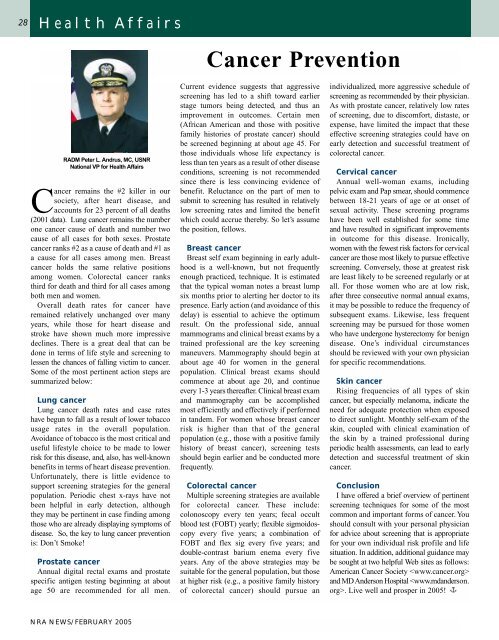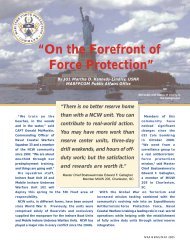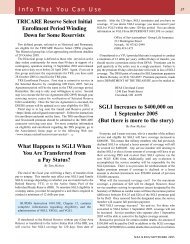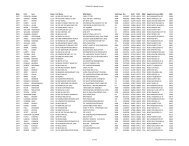Information Track for New Naval Reservists
Information Track for New Naval Reservists
Information Track for New Naval Reservists
- No tags were found...
Create successful ePaper yourself
Turn your PDF publications into a flip-book with our unique Google optimized e-Paper software.
28Health AffairsCancer PreventionRADM Peter L. Andrus, MC, USNRNational VP <strong>for</strong> Health AffairsCancer remains the #2 killer in oursociety, after heart disease, andaccounts <strong>for</strong> 23 percent of all deaths(2001 data). Lung cancer remains the numberone cancer cause of death and number twocause of all cases <strong>for</strong> both sexes. Prostatecancer ranks #2 as a cause of death and #1 asa cause <strong>for</strong> all cases among men. Breastcancer holds the same relative positionsamong women. Colorectal cancer ranksthird <strong>for</strong> death and third <strong>for</strong> all cases amongboth men and women.Overall death rates <strong>for</strong> cancer haveremained relatively unchanged over manyyears, while those <strong>for</strong> heart disease andstroke have shown much more impressivedeclines. There is a great deal that can bedone in terms of life style and screening tolessen the chances of falling victim to cancer.Some of the most pertinent action steps aresummarized below:Lung cancerLung cancer death rates and case rateshave begun to fall as a result of lower tobaccousage rates in the overall population.Avoidance of tobacco is the most critical anduseful lifestyle choice to be made to lowerrisk <strong>for</strong> this disease, and, also, has well-knownbenefits in terms of heart disease prevention.Un<strong>for</strong>tunately, there is little evidence tosupport screening strategies <strong>for</strong> the generalpopulation. Periodic chest x-rays have notbeen helpful in early detection, althoughthey may be pertinent in case finding amongthose who are already displaying symptoms ofdisease. So, the key to lung cancer preventionis: Don’t Smoke!Prostate cancerAnnual digital rectal exams and prostatespecific antigen testing beginning at aboutage 50 are recommended <strong>for</strong> all men.Current evidence suggests that aggressivescreening has led to a shift toward earlierstage tumors being detected, and thus animprovement in outcomes. Certain men(African American and those with positivefamily histories of prostate cancer) shouldbe screened beginning at about age 45. Forthose individuals whose life expectancy isless than ten years as a result of other diseaseconditions, screening is not recommendedsince there is less convincing evidence ofbenefit. Reluctance on the part of men tosubmit to screening has resulted in relativelylow screening rates and limited the benefitwhich could accrue thereby. So let’s assumethe position, fellows.Breast cancerBreast self exam beginning in early adulthoodis a well-known, but not frequentlyenough practiced, technique. It is estimatedthat the typical woman notes a breast lumpsix months prior to alerting her doctor to itspresence. Early action (and avoidance of thisdelay) is essential to achieve the optimumresult. On the professional side, annualmammograms and clinical breast exams by atrained professional are the key screeningmaneuvers. Mammography should begin atabout age 40 <strong>for</strong> women in the generalpopulation. Clinical breast exams shouldcommence at about age 20, and continueevery 1-3 years thereafter. Clinical breast examand mammography can be accomplishedmost efficiently and effectively if per<strong>for</strong>medin tandem. For women whose breast cancerrisk is higher than that of the generalpopulation (e.g., those with a positive familyhistory of breast cancer), screening testsshould begin earlier and be conducted morefrequently.Colorectal cancerMultiple screening strategies are available<strong>for</strong> colorectal cancer. These include:colonoscopy every ten years; fecal occultblood test (FOBT) yearly; flexible sigmoidoscopyevery five years; a combination ofFOBT and flex sig every five years; anddouble-contrast barium enema every fiveyears. Any of the above strategies may besuitable <strong>for</strong> the general population, but thoseat higher risk (e.g., a positive family historyof colorectal cancer) should pursue anindividualized, more aggressive schedule ofscreening as recommended by their physician.As with prostate cancer, relatively low ratesof screening, due to discom<strong>for</strong>t, distaste, orexpense, have limited the impact that theseeffective screening strategies could have onearly detection and successful treatment ofcolorectal cancer.Cervical cancerAnnual well-woman exams, includingpelvic exam and Pap smear, should commencebetween 18-21 years of age or at onset ofsexual activity. These screening programshave been well established <strong>for</strong> some timeand have resulted in significant improvementsin outcome <strong>for</strong> this disease. Ironically,women with the fewest risk factors <strong>for</strong> cervicalcancer are those most likely to pursue effectivescreening. Conversely, those at greatest riskare least likely to be screened regularly or atall. For those women who are at low risk,after three consecutive normal annual exams,it may be possible to reduce the frequency ofsubsequent exams. Likewise, less frequentscreening may be pursued <strong>for</strong> those womenwho have undergone hysterectomy <strong>for</strong> benigndisease. One’s individual circumstancesshould be reviewed with your own physician<strong>for</strong> specific recommendations.Skin cancerRising frequencies of all types of skincancer, but especially melanoma, indicate theneed <strong>for</strong> adequate protection when exposedto direct sunlight. Monthly self-exam of theskin, coupled with clinical examination ofthe skin by a trained professional duringperiodic health assessments, can lead to earlydetection and successful treatment of skincancer.ConclusionI have offered a brief overview of pertinentscreening techniques <strong>for</strong> some of the mostcommon and important <strong>for</strong>ms of cancer. Youshould consult with your personal physician<strong>for</strong> advice about screening that is appropriate<strong>for</strong> your own individual risk profile and lifesituation. In addition, additional guidance maybe sought at two helpful Web sites as follows:American Cancer Society and MD Anderson Hospital . Live well and prosper in 2005!NRA NEWS/FEBRUARY 2005
















